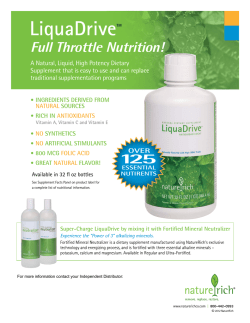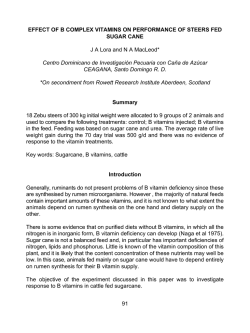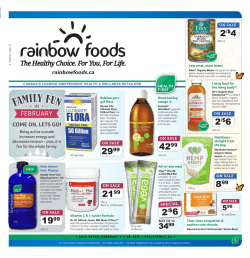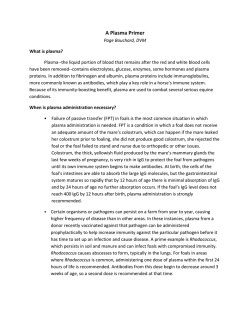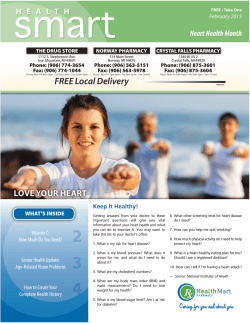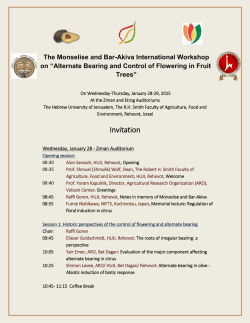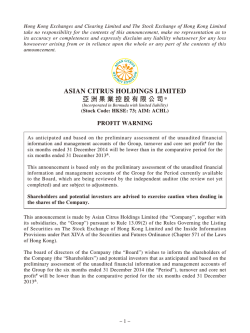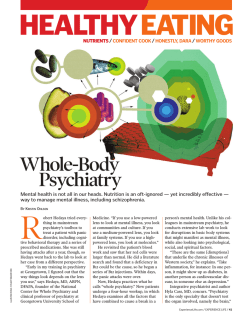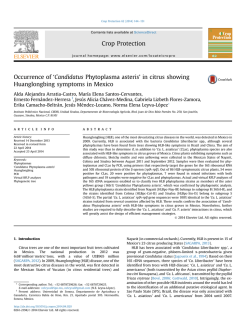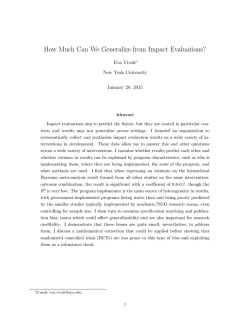
Effect of Vitamins A, E and a Citrus Extract on in vitro and in vivo lipid
Medical Science Research, 1992, 20, 145-146. Effect of Vitamins A, E and a Citrus Extract on in vitro and in vivo lipid peroxidation Joe A. Vinson and Chi Hsu Department of Chemistry, University of Scranton, Scranton, PA. 18510-4626, USA. Introduction Oxygen, though necessary for life is a toxic substance. Fortunately, 98% of the oxygen is completely reduced to water in the process of respiration. The other 2% turns into potentially toxic free radical oxidants [1]. Theses substances can damage proteins, nucleic acids, carbohydrates and polyujnsaturated fatty acids. They can also directly reduce the level of antioxidant defence molecules in the plasma [2]. Free radical-meditated lipid peroxidation has been imploicated in several disease state including cancer, rheumatoid arthrits, potischaemic reoxygentation injury, as well as in the degenerative processes associated with atherosclerosis, diabetes and aging [3]. There has been a paucity of research on the effect of vitamin supplementation on lipid peroxides in humans. The purpose of this research was to examine several antioxidant (AOX) vitamins and their effect on in vitro and in vivo lipid peroxidation. Vitamins in a natural matrix were studied as they have been shown to have a greater animal and human absorption and retention than synthetic vitmains alone [4]. Materials and methods Vitamin A was retinyl palmitate in carrot concentrate (250,000 IU g-1). Vitamin E was tocopherol acetate in vegetable oils (250 IU g-1). Citrus extract was a dried water/alcohol extract of orangette fruit which contained 18.1% bioflavonoids (naringin, naringenin and hesperidin), 50% proteins and 25% carbohydrates. In order to test for in vitro inhibition of lipid peroxidation, we used the procedure of Jain and McVie [5]. Red blood cells (RBC) were isolated from a single healthy individual. 100μl of RBC were incubated with 1ml of isotonic solutions of normal glucose in Hanks Balanced Salt Medium (5.5 mM) or high glucose (55.5mM) Hanks solution at pH 7.4 for 24 hours at 37°C in a shaking water bath. Water soluble citrus extract was disolved in the Hanks solution. Fat soluble vitamins A and E in methanol were ultrasonified with the Hanks solution. Following the incubation, the procedure of Jain and McVie [5] was used to measure lipid peroxides (LPO). Tetraethoxypropane was used to generate malondialdehyde in situ as standard. The absorbance of the membrane filtered solutions form the RBC incubations was corrected for haemoglobin [6]. Lipid peroxides concentration was expressed in thiobarbituric acid reactive substances (TBARS). Statistical significance was determined by a two-tailed t-test. All subjects volunteered for the in vivo supplementation studies with informed consent. The protocol was approved by the Institutional Human Subjects Committee. Five normal disease free subjects, four male and one female, aged 19 to 32 years, mean 28± 5 years, participated in the single vitamin supplementation studies. Six subjects took part in the combination vitamin study. There were five males and one female, aged 20 to 32 years, mean 26± 5 years. 5/6 of the subjects were from previous studies. Each subject appeared after a overnight fast for a venous blood sampling into an EDTA tube. The plasma was frozen at -20°C until analysed a few days later. A 24h urine was collected and refrigerated until analysis. TBARS were measured as in the invitro study. Each subject then consumed single vitamins for a period of 2 weeks and another fasting blood sample and 24 h urine sample was taken. A 2 week wash-out period then ensued followed by another sampling and vitamin supplementation for 2 weeks. following the four single vitamin supplementations, a combination of A, E and citrus extract was taken for 2 weeks and sampling done as before. Vitamins were consumed by volume with the following daily doses: Vitamin A 10,000 IU, Vitamin E 800 IU and citrus extract 4g. The combined supplement provided the same dose of vitamins A, E and citrus extract as in the single vitamin studies. Statistics were performed using a two sample t-test. Results and discussion The results of the RBC incubation are shown in Table 1. The high glucose media produced a significantly higher amount of LPO than the normal glucose media as also shown by Jain and McVie [5]. This was hypothesised to be due to the greater concentration of NADPH in the hyperglycaemic media which stimulated the NADPH- dependent cytochrome P-450-like activity of haemoglobin. In turn, this caused an increase in oxygen radicals and a subsequent increase in lipid peroxidation [5]. Table 1: Effect of Vitamins A, E and a Citrus extract on glucose induced in vitro red blood cell lipid peroxidation (means ± SD; n in parenthesis). Incubation Inhibitor (concentration) TBARS (μM) Normal glucose control, 5.5mM (7) 5.96 ± 0.38 High glucose control, 55.5mM (7) 8.27 ± 0.72* High glucose (3) Vitamin A (17.5 μM) 2.15 ± 0.45** High glucose (3) Vitamin E (110 μM) 6.92 ± 0.20** High glucose (3) Citrus extract (3.60mg/ml) 1.29 ± 0.11** * As compared with normal glucose control, p < 0.01. ** As compared with high glucose control, p < 0.05. Vitamins A and E were incubated at approximately 5 times the physiological concentration. Citrus extract was at a concentration of 3.60 mg ml-1 which is equivalent to 0.65mg ml-1 bioflavonoids. All three of these substances gave significant inhibition of LPO in the high glucose medium when compared to the control. Vitamin A and citrus extract were such effective inhibitors that they significantly decreased LPO in the high glucose media below that in the normal glucose control media. A statistical comparison of the 3 inhibitors revealed that citrus extract was the most powerful inhibitor (p < 0.05). Due to the fact that higher than physiological concentrations of the vitamins A and E and Citrus extract resulted in a decrease in LPO, an in vivo supplementation study was initiated. Plasma TBARS is commonly measured in anti-oxidant supplementation studies. However, it has been recently shown that 24h urine TBARS is an excellent indicator of lipid peroxidation in vivo [7]. Therefore both plasma and urine TBARS were analysed and the results are shown in Table 2. There was considerable variation between the pre-supplement TBARS probably due to dietary effects. Table 2: Effects of antioxidant supplementation on plasma and urine lipid peroxidation (means ± SD; n in parenthesis). Plasma TBARS (μM) Urine TBARS (μmol/24h) Supplement Pre-supplement Post-supplement Pre-supplement Post-supplement A (5) 2.89 ± 0.67 2.31 ± 0.44 14.6 ± 4.1 11.5 ± 2.2 E (5) 3.84 ± 0.45 2.91 ± 0.74* 23.7 ± 7.9 21.3 ± 7.1 2.89 ± 0.67 3.73 ± 1.23 2.35 ± 0.20* 13.1 ± 4.5 13.6 ± 2.6 Combination (6) 2.68 ± 0.67 1.81 ± 0.18** 10.3 ± 0.8 7.2 ± 3.3** * As compared with pre-supplement, p < 0.05. ** As compared with pre-supplement, p < 0.01. None of the subjects experienced any side effects from consuming these supplements, which were mixed with fruit juice or milk and drunk as a suspension. Daily doses of vitamins A and E were 3 and 80 times the respective RDA [8]. Vitamin A produced a non-significant decrease in plasma TBARS. Supplementation of Vitamin E resulted in a significant decrease in plasma TBARS. All five subjects experienced a decrease. Citrus extract produced a significant decrease in plasma TBARS in all five subjects. The combination of vitamins A, E and Citrus Extract caused a significantly lower post-supplementation plasma TBARS than any of the single supplements, p < 0.05. The combination caused an average decrease of 30.1% in plasma TBARS. None of the single AOX supplements produced a significant change in urine TBARS. The combination supplement significantly decreased 24h urine TBARS in all six subjects. The combination produced a lower post-supplementation plasma TBARS than any of the single supplements, p < 0.05. The combination caused an average decrease of 34.1% in urine TBARS. There was a linear correlation of plasma TBARS and urine TBARS using all the data from the supplementation studies. The equation is : 24h urine TBARS (μmol) = 3.05 plasma TBARS (μM) + 5.93. The correlation was significant with p = 0.012, r = 0.38 and n = 42. As shown in the present study 24 h urine TBARS reflects in vivo lipid peroxidation. Collection of urine is less invasive than blood and thus urine should prove to be a useful fluid for analysis during supplementation studies. Vitamin A is not a well known AOX. An agreement with the present human study, Tom et al [9] showed that excess vitamin A in the rat diet produced significantly less LPO than a diet sufficient in vitamin A. Vitamin E was found in the present study to be an effective in vitro RBC LPO inhibitor as seen by Jain and McVie [5]. Vitamin E was a significant LPO inhibitor in normal subjects in the present study and was also shown to be effective in elderly subjects [10]. Bioflavonoids contained in the citrus extract have been shown to be powerful in vitro inhibitors of RBC LPO [11]. The AOX supplements described in the present study should find greatest use in the therapy for heart disease since the link between LPO and pathology has been firmly demonstrated. The currently accepted mechanism for atherosclerosis is the oxidation of LDL. In vitro studies by Esterbauer et al. [12] have shown that LDL becomes oxidised only after the depletion of the endogenous vitamins A, E and beta-carotene. Human supplementation with vitamin E has rendered the LDL less prone to in vitro oxidation by Cu2+ [13] and to in vivo oxidation by smoking [14]. The beneficial effect of citrus extract in the present study is corroborated by the fact that bioflavonoids inhibit in vitro oxidation of LDL and conserve the vitamin E content of LDL [15]. This latter finding could explain the greater effectiveness of the combination of all three AOX since vitamins A and E bind to lipoproteins and bioflavonoids conserve vitamin E. Although LDL lipid peroxides were not measured in the present study, plasma TBARS measurement is useful since the values linearly correlate with LDL oxidisability [16] and thus are a good indication of LDL lipid peroxides. The citrus extract plus vitamin C has also been found in our laboratory (unpublished results) to significantly decrease total cholesterol and low density lipoprotein cholesterol (LDL). Diabetes [3] and hyperlipaemia [17] produce plasma elevations in LPO of 20-40% above normal in humans. The combination AOX supplement described in this work decreased plasma LPO 30% in normal subjects. Thus, the results of the present study indicate that AOX supplements, especially in a combination where additivity is possible, should be investigated as therapy for lowering LPO in disease. References 1. Simmons, K. 1984, J. Am. Med. Assoc., 251, 2187-2192 2. Frei, B., Stocker, R. and Amex, B.N., 1988, Proc. Natl. Acad. Sci. USA, 85, 9748-9752. 3. Yagi, K. 1987, Chem. Phys. Lipids, 45, 337-351. 4. Vinson, J.A.,Bose, P., Lemoine, L. and Hsiao, K., 1989, In; Southgate, D., Johnson, I. and Fenwick, G.R. (eds.) Nutrient Availability: Chemical and Biological Aspects, pp 125-127. Royal Society of Chemistry, Thomas Graham House, Cambridge, UK. 5. Jain, S. and McVie, R. 1987. Diabetes 36, Supplement 186A. 6. Gilbert, H.S., Stump, D.D. and Roth, E.F., Jr 1984, Biochem., 137, 282-286. 7. Knight,J., Smith, S., Kinder, V. and Pieper, R. 1988, Clin. Chem., 34, 11071110. 8. 9. 10. 11. 12. 13. 14. 15. 16. 17. National Research Council, 1989, Recommended Dietary Allowances, 10th Ed., National Academy Press, Washington, D.C., USA. Tom, W.M., Prasongwataya, V. and Boyle. T.R.C., 1985, Experientia, 41, 1046-1047. Meydani, S.N., Barklund, M.P., Liu, S. et al. 1990, Am. J. Clin. Nutr., 52, 557563. Salvayre, R., Negre, A., Affanny, A. et al 1988. In : Cody, E., Harborne, J. and Beretz, A. (eds.), Plant Flavonoids in Biology and Medicine11, pp 313-316, Alan R. Liss, New York, USA. Esterbauer, H., Striegl, G and Puhl, H. et al. 1989, Ann. N.Y. Acad. Sci., 570, 254-267. Esterbauer, H., Dieber-Rotheneder, M., Waeg, G. et al 1990, Biochem. Soc. Trans., 18, 1059-1061. Harats, D., Ben-Nain, B., Dabach, et al 1990, Atherosclerosis, 85, 47-54. DeWhalley, C.V., Ranking, S.M., Hoult, J.R.S. et al 1990, Biochem. Pharmacol., 39, 1743-1750 Babiy, A.V., Gebickt, J.M. and Sullivan, D.R., 1990, Atherosclerosis, 81, 175182. Loeper, J., Emerit, J., Goy, J et al. 1983, Med. Sci. Res., 11, 1034-1035.
© Copyright 2025
